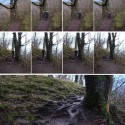A Tree along the shore of Loch Lomond
A week before the winter solstice Tim and I decided to spend a day walking amongst the trees on the east side of Loch Lomond in the Trossachs National Park. It is about forty minutes away from the city of Glasgow where we live. We stopped at a visitor centre in Balmaha (from the Gaelic for St Maha’s Place) and asked the National Park Ranger where was we might see some older native trees. The lady said the trees were not very old in this area but there was a path along the loch that would go through an oak wood that was mixed with hazel.
We parked the car at the Millarochy Bay beach. The sky was a deep greyish blue but not windy. After a bitter cold start of December, the snow and ice had melted. It was a good day to be outside. The path was covered with dark brown oak leaves. The cliff along the shoreline was held by large the roots of oak trees, which were exposed and the tree trunks were bent as they struggled to balance and hold the slope over time. The cliff was made of red sandstone and the beach was the same although studded with green serpentine pebbles; indicating proximity to the Highland Boundary Fault. Tim and I enjoyed this natural beauty and marvelled at the cause and affect relationship between time, geology, the soil and the trees over time.
The Trossachs National Park is one of the world’s newest National Parks; it opened in 2002. It is a landscape in transition, sheep are off the land for the first time in centuries, deer fences protect new planting of native Scotts pine and broad leaf trees. Small thick birch trees with strong roots have grown in the bracken areas, cut back each year by the sheep yet they survived. These strong bonsai like trees are part of the spirit of a future forest. One of many cause and affect relationships which shape the aesthetic perception of landscape in Scotland.
As we walked in the cool air, heading south, the lake on our right; there was a spot on the path where we had to climb from a beach up to a ledge.. We found ourselves touching a great tree next to the path. It was an old sycamore covered by beautiful lichens and mosses; it caused us to pause and look more closely. The tree roots had developed as staircase that fit our feet perfectly. Tim said, “This tree has been touched by everyone, everyday who walks along this path.” The shape of the tree is the result of case and affect relationship between the tree and the people. The tree seems to accept human interaction. If the interaction was difficult for the tree, it would grow in a different direction, or whither and die back; yet this tree seemed to prosper with the attention. We went back and forth many times to experience the tree and talk about conjoined relationships between people and trees.
The sun was going down at a half past three. We had to keep going, but we left with the feeling of that tree firmly planted in our hearts and minds, our passions engaged through experience.
Reiko Goto and Tim Collins
December 15, 2012
